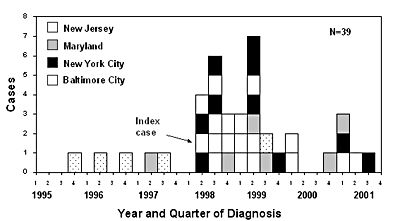Guide to the Application of Genotyping to Tuberculosis Prevention and Control
Tuberculosis Genotyping Case Studies: How TB Programs Have Used Genotyping
Investigation of a Multistate Tuberculosis Outbreak: The Importance of Comparing Genotype Results Between Adjacent TB Programs
From June 1998 through June 1999, 15 young African-Americans from Baltimore, Maryland and New York City developed TB with isolates that had a matching RFLP pattern (McElroy 2002). All but one of the patients were members of the transgender community and belonged to a social organization that regularly met to dance and participate in dressing competitions known as “balls.”
Since members of this social organization traveled widely, health officials were concerned that transmission of this outbreak strain could be occurring in other cities. To search for additional patients whose isolates might match the outbreak genotype, the investigators took advantage of the National Tuberculosis Genotyping and Surveillance Network database, which contains over 6,000 unique RFLP images. This search revealed four previously unrecognized matches—three were found to be close contacts of a transgender person who was involved in the outbreak (one lived in the same house, one worked at the same location, and the third worked as a custodian on the same floor as the patient). The fourth patient with a matching genotype, a 42-year-old man, died before he could be interviewed.
Additional isolates for genotyping were obtained from laboratories in New York City, Atlanta, and Philadelphia by searching existing TB records for patients that fit the outbreak profile. This search came up with eight additional patients, all from New York City, with isolates matching the outbreak strain. Interviews revealed that all but one were part of the same transgender social group. During the investigation, five additional patients who had epidemiologic links to the original outbreak-associated patients, developed TB, and the genotypes of their isolates matched the outbreak strain (Figure 2.1). Another patient, a 7-year-old girl, developed clinical TB but never had a positive culture result. Although no isolate was available to prove that she was infected with the outbreak strain, this is likely, since she became ill while living with her sister, one of the outbreak patients. This outbreak investigation shows the importance of being able to compare genotyping results between adjacent TB programs.

Figure 2.1. Epidemic curve of investigation of a multistate TB outbreak among transgender persons involving cases from New Jersey, Maryland, New York City, and Baltimore. A search of the National Tuberculosis Genotyping and Surveillance Network genotyping database led to the identification of four additional outbreak-related cases (McElroy 2002).
- Page last reviewed: September 1, 2012
- Page last updated: September 1, 2012
- Content source:


 ShareCompartir
ShareCompartir